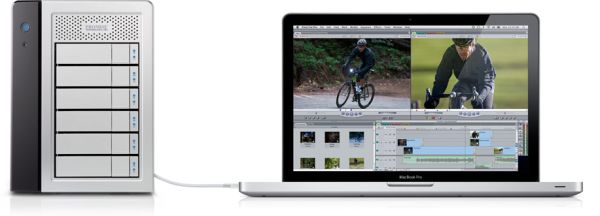MacBook Pro 2011 Refresh: Specs and Details
by Andrew Cunningham on February 24, 2011 4:40 PM ESTThunderbolt
The new MacBook Pros offer the array of ports we're used to, plus something a bit different.
A new port called Thunderbolt replaces the Mini DisplayPort found in earlier models. Formerly codenamed Light Peak, the new Intel standard promises up to 10 Gbps bi-directional data transfer speeds and connectivity for an array of devices, from displays to hard drives. The standard also supports 8-channel audio, which should make for easy connection to HDMI devices with the right adapter, and up to six different Thunderbolt devices can be daisy chained together according to the Intel specs.
Most of the given use scenarios for Thunderbolt focus on external hard drives, displays, and HD video hardware, and adapters for existing standards like eSATA and Firewire. If Thunderbolt ports become more widespread, we'll probably see additional applications of the standard.

Finally, it's worth noting that if you've already spent money on Mini DisplayPort adapters, dongles and cables for your existing Mac, those accessories will continue to work with the new Thunderbolt port.
Look for more from us on Thunderbolt shortly.
Conclusions
Thunderbolt aside, there's not much that surprises about the new MacBook Pro lineup - as usual, new, faster hardware is being sold to us in the same attractive unibody case to which we've become accustomed.
Most of the additions are welcome, though the value proposition continues to be a struggle. As usual, to save money, you're better off buying the base model and adding RAM or a new hard drive yourself than paying Apple's price for upgrades.
The move to Sandy Bridge is interesting but the lack of any mention of Quick Sync is a bit bothersome. We’re working on our review of the new platforms, expect to see results in the coming days.











128 Comments
View All Comments
iblastoff - Friday, February 25, 2011 - link
wtf are you talking about? First of all USB 3.0 is definitely not standard on sandy bridge machines. Secondly since when does apple "hate USB". It's pretty common knowledge they were one of the very first to push USB as a multi peripheral interface.tomoyo - Thursday, February 24, 2011 - link
What standard? No sandy bridge chipset supports usb 3.0 yet.KPOM - Thursday, February 24, 2011 - link
I'm sure Apple didn't include it natively because they want to push Thunderbolt. Steve Jobs was as dismissive of USB 3.0 as he is of BluRay. Technically, someone can release a Thunderbolt to USB 3.0 adapter.dagamer34 - Friday, February 25, 2011 - link
Less dismissive, more like "Intel isn't supporting it natively, and we aren't going to pay the extra $15 for an external controller taking up space on our cramped motherboard" or something to that extent...fteoath64 - Saturday, February 26, 2011 - link
"Technically, someone can release a Thunderbolt to USB 3.0 adapter".Nope, you still need a host USB3 chip on the motherboard. It is really a tragedy that Apple did NOT include USB3 ports on this, its a small chip and cost a few dollars.
SATA3 would be very nice too but I doubt it has that either ! Double bummer.
DtheMan - Thursday, February 24, 2011 - link
No mention that battery life has gone from 9+ hrs to 7 hrs. Not sure of the specs, but has the watt hours of the battery been decreased, or I'd be really surprised if this platform consumes more power than the prior one.You should get longer play time for videos, purely because of Sandy Bridge's video engine, but what about using this for work or other things. 8 or nine hours is a sweet spot, especially for long flights. It's a typical work day for many. Not sure why Apple opted to reduce this, other than perhaps cost
Cat - Thursday, February 24, 2011 - link
Apple's battery life test suite has changed.solipsism - Thursday, February 24, 2011 - link
To elaborate a little on Cat’s comment, Jobs mentioned they changed there testing methods when they introduced the MBAs. The battery size hasn’t changed, and may actually be a little longer in real world use due to the advantages of Sandy Bridge.KPOM - Thursday, February 24, 2011 - link
If you'll notice, they also reduced the stated life of the battery on the MacBook (which did not change one iota today).They changed their testing methods starting with last year's MacBook Air. They could do a better job of explaining it.
dagamer34 - Friday, February 25, 2011 - link
Battery testing has changed and the CPU itself uses more power on the 15"/17" (45W now vs. 35W previously)